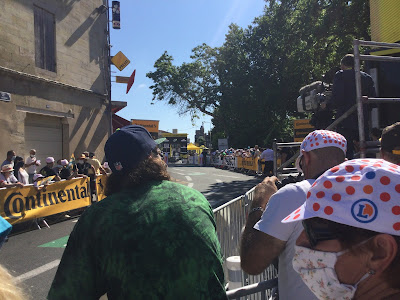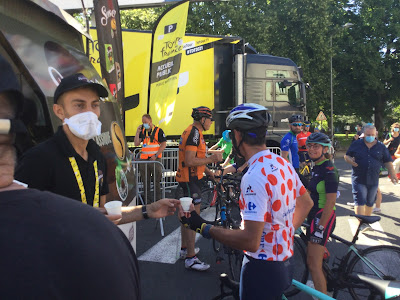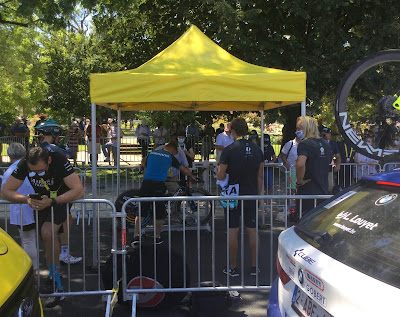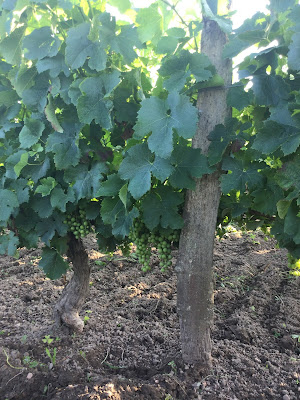Turns out I did, which I had confirmed at the US Embassy just off The Tour de France route by the Place de la Concorde. I didn’t have to enter the embassy as just as I arrived a young American was leaving. She told me she was flying back the next day and confirmed that one needed the Covid test, which wasn’t necessary a month ago when I arrived if one had been vaccinated. She said I could get take the test at any pharmacy and they’d give me my results in ten minutes and the papers I needed.
The pharmacy I went to just down the street from Ralph’s apartment knew the procedure well and gave me all the documentation required, including the name of the person who administered the test. Ralph thought it might be free, but it was only twenty-five euros.
My extra two days in Paris gave me the opportunity to search out some sites relevant to The Tour de France that I have long been curious to visit but haven’t had the opportunity. One was the Vélodrome in Vincennes just east of Paris where The Tour used to finish before it gained the privilege of taking over the Champs Élysées. The change was made in 1975 and has continued every year since.
It was hard to imagine that the grand finale took place on this rather paltry Vélodrome built in 1894, but it had been the standard in its day hosting the Olympics in 1900 and 1924. It was the main venue for multiple events in 1900, but was restricted to just cycling in 1924.
Ralph and I were in no hurry, so we kept up our search going out beyond the wall surrounding the Vélodrome past the shaded entry to look back on the Vélodrome and the wall around it. Still nothing, but as we returned to our bikes on the other side of the half-opened gate, Ralph looked up and noticed the word Pellisier on a dark slab of wood just above the gate. That was it—an old, weathered bas-relief with their faces and first names—Henri, Francis and Charles. It was very nice, but quite obscured, so much so that people who worked there had never noticed it. And we wouldn’t have either if it hadn’t been for a chance glance by Ralph.
Christophe is also renowned for twice breaking the fork of his bike causing him to lose The Tour. The most celebrated was during the 1913 Tour on a descent of the Tourmalet. Riders were obligated to perform all repairs on their bikes. He ran down the mountain to a blacksmith shop to weld his fork back into operating order. He was penalized ten minutes, later reduced to two, for enlisting the help of a young boy to operate a bellows. The penalty was incidental, as he lost over two hours to the repair. The incident is so famous that there is a plaque on the building where it took place and the repair was recreated fifty years later by Christophe and the boy, well advanced in years at the time.
Ralph had been wanting to visit his grave for awhile, but had never gotten around to it. I was happy to make it an excursion, though the route for cyclists that Ralph’s GPS device offered seeking out bike paths turned out to be an ordeal battling the dozens and dozens of commuting cyclists all hell-bent on getting to work on time. We would have been much better off sticking to the main thoroughfares, most of which have space for bikes, often with barriers.
Paris has developed a very impressive cycling infrastructure, but the cyclists are all too often very reckless, making the cycling quite hazardous. Ralph is reluctant to cycle at all. He is so infuriated by all the cyclists running red lights that it is his fantasy to hang out at a busy cycling intersection with a baseball bat and have at their noggins when they fly past.
Halfway to the cemetery we left the cycling paths along the Seine and had relatively peaceful riding on real roads, the final. Couple of miles through forest to the cemetery. A map at itw entry showed the location of the higher profile people buried there. Oir search was also assisted by a photo of Tarkovsky’s grave Ralph had lifted from the internet. The photo helped a lot, as the name on the grave was the Russian version of Tarkovsky, which we never would have recognized. Without the photo our only hope would have been knowing the dates of his birth and death 1932 and 1986. His grave was the only one in the huge cemetery with a bench beside it. Two other gentlemen came to the grave while we were there. They were too wrapped up in their own conversation to include us.



















































